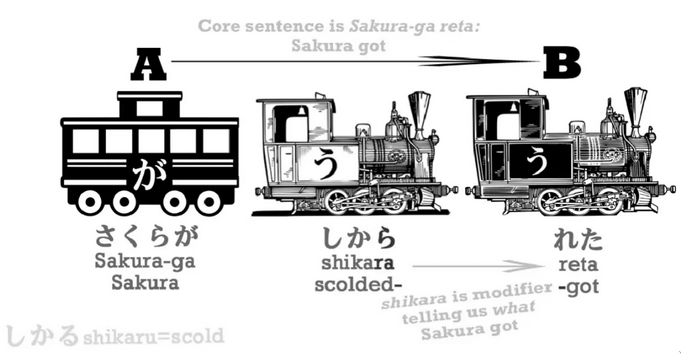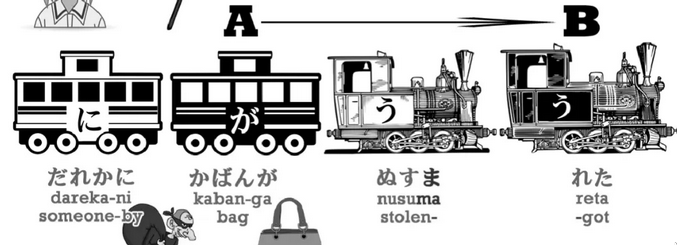Hay còn được gọi là: thể bị động (受身形), nó đúng hơn là trợ động từ mang nghĩa "bị" hoặc "được" – hay gọi là trợ từ tiếp nhận (receptive helper verb) cũng được.
 Nó là một Động từ phụ gắn vào stem あ (a-stem) của động từ chính. Bao gồm có hai dạng:
Nó là một Động từ phụ gắn vào stem あ (a-stem) của động từ chính. Bao gồm có hai dạng:
- 「れる」dùng cho godan.
- 「られる」dùng cho ichidan.
Nó mang nghĩa "bị" hoặc "được" – tức là nhận lấy hành động (động từ chính) ấy. Có thể so sánh với get trong Tiếng Anh: get hành động gì đó, kiểu như get done, get cleaned, .etc.
「さくらがしかられた。」---「叱る(しかる)」= la mắng -> Gốc dạng あ là 「叱ら」-> Thêm 「れる」 vào thành 「叱られる」= bị la -> Quá khứ là 「叱られた」= đã bị la → Sakura đã bị la mắng.
 「水が飲まれた」→ Nước đã bị uống.「飲む」= uống → 「飲ま」 là gốc → 「飲まれる」= bị uống. Chủ thể thật sự là nước, vì nước là thứ bị uống, là đối tượng "nhận lấy hành động".
「水が飲まれた」→ Nước đã bị uống.「飲む」= uống → 「飲ま」 là gốc → 「飲まれる」= bị uống. Chủ thể thật sự là nước, vì nước là thứ bị uống, là đối tượng "nhận lấy hành động".
Một câu đầy đủ
さくらはだれかにかばんがぬすまれた。
Hãy luôn nhớ rằng, các trợ từ (particles) sẽ không bao giờ bị thay đổi chức năng, dù ở bất kể trường hợp nào.
Who is the receiver of the action? It's the person who's marked by が, and that's the bag. The bag is what received that stealing, so the bag is the subject of the sentence. The bag is the one who did れる, who did got.
Giải thích cho cái に.... (Không hiểu cách giải thích trên video lắm)

に marks the target of where I’m going. Now in a れる/られる sentence, the target doesn’t change, but れる/られる changes the direction of what’s happening to the speaker. 私が優さんに蹴られた。”I received a kick from yuko”. Or in plain English “I was kicked by Yuko. Why then does に change? It doesn’t. It is still marking the target. られる changes the flow, but it is still from the speaker’s perspective. The target is making an action or some sort of movement towards the speaker.
Một cách giải thích hay khác từ phần bình luận:
Imagine if this was a fighting game and the に particle marked the enemy fighter in red. Normally the に particle means all your attacks go to the red opponent. But れる/られる changes from you throwing punches. To you being punched. From your perspective. He’s still your target. Your opponent. But you’re target is れる/られる ing you. And now you’re dead lol. Never throughout the fight did the perspective change, you’re still the player, fighting the に opponent. れる/られる only changes you hitting the opponent, to you being hit by the opponent. It’s like a fixed camera. You can’t take player two’s perspective. You can only see through player one’s eyes. You are either beating your opponent, or receiving blows from your opponent. All the while he is still your opponent. Your target.
迷惑受け身 (Phiền)
「さくらはだれかにかばんがぬすまれた。」means Sakura's **bag** got stolen by someone or, literally, In relation to Sakura, **bag** got stolen by someone. But we can also say 「さくらがだれかにかばんをぬすまれた。」 This is the nuisance receptive. So what does this sentence mean in English? Very simple: **Sakura** got her bag stolen
Ghi them
こんにちは! もしかしてこちらに 引っ越してこられた(passive form of kuru)方ですか? (引っ越してこられた方 to 引っ越してきた方) passive tense can be used to add politeness/respect
